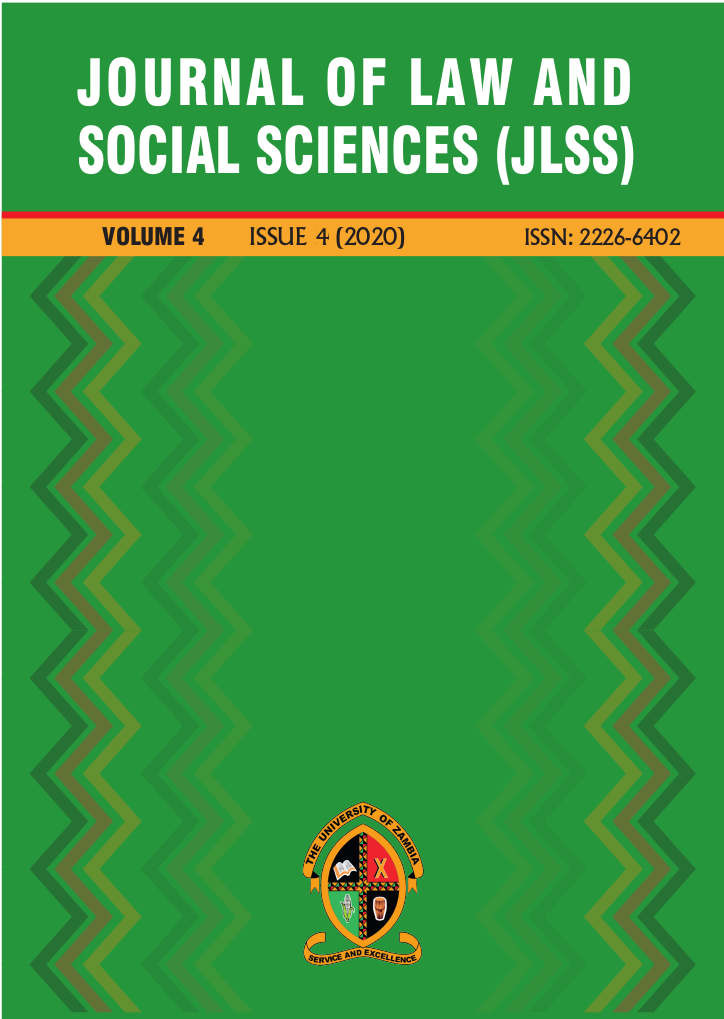The Significance of Land in Chinua Achebe’s Things Fall Apart
Keywords:
Culturescape, Nature Culture, Centrality of Land, Ecocriticism, African Ecocriticism, Ecophilosophy, Traditional Religion, Social Constructionism, Okonkwo
Abstract
This article is concerned with the significance of land in Chinua Achebe’s seminal work ‘Things Fall Apart’. It focuses on questions of how the land is distributed and utilised and the attitudes and beliefs surrounding it. In handling the question, the article analyses various situations and contexts in which issues of land and its use arise. The main tool of analysis is ecocriticism complemented by the social constructionist theory. The article argues that the Igbo culture as presented in Things Fall Apart is a nature-culture characterised by land as a culture-scape. The beliefs of the Igbo determine how they relate to and use the land. Further the article argues that land is very central to the life and lifestyle of the Igbo people as it helps define their religion and customary practices.References
1. Achebe, C. (1958), Things Fall Apart, London: Heinemann Educational Books Ltd.
2. Barry, P. (2002), Beginning Theory: An Introduction to Literary and Cultural Theory, Manchester and New York: Manchester University Press.
3. Chilala, C. (2003). Marriage, Gender and Freedom in Henrik Ibsen’s A Doll’s House: A Zambian Perspective. Proceedings of the Relevance of A Doll’s House. Dhaka: Centre for Asian Theatre, 101-118.
4. Chilala, C. (2011). The African Narrative Tale as a Tool of Education. Key Concepts in Theatre/Drama Education. Amsterdam: Brill, 159-162.
5. Chilala, H.K.C. (2016), ‘Footprints of Caliban: Appropriation of English in Selected African Fictional Texts’. In: Ufahamu: A Journal of African Studies, Vol. 39, Issue 2, 59-72.
6. Chilala, C. (2019), ‘Gendered Spaces in Chinua Achebe’s Things Fall Apart: Text, Context and Pretext’. In: Felix Banda (Ed.), Theoretical and Applied Aspects of African Languages and Culture, Cape Town: University of the Western Cape (CASAS), 317-339.
7. Glotfelty, C. and Harold F. (eds.) (1996), The Ecocriticism Reader: Landmarks in Literary Ecology, Athens: University of Georgia Press.
8. Kammampoal, B. and Suuk, L. (2019), “The Kola Nut: Its Symbolic Significance in Chinua Achebe’s Things Fall Apart”. In: International Journal of Studies in English Language and Literature (IJSELL), Volume 7, Issue 8, August, pp. 26-40.
9. Manganaro, M. (2002). Culture, 1922. Princeton and Oxford: Princeton University Press.
10. Mthatiwa, S. (2016), “Animals, Nostalgia and Zimbabwe’s Rural Landscape in the Poetry of Chenjerai Hove and Musaemura Zimunya”. In: F. Fiona Moolla (Ed.), Natures of Africa: Eco-criticism and Animal Studies in Contemporary Cultural Forms, Johannesburg: Wits University Press, 276-303.
11. Musiyiwa, M. (2016), “Shona as a Land-Based Nature-Culture: A Study of the (Re)Construction of Shona Land Mythology in Popular Songs”. In: F. Fiona Moolla (Ed.), Natures of Africa: Ecocriticism and Animal Studies in Contemporary Cultural Forms, Johannesburg: Wits University Press, 49-76.
12. Rueckert, W. (1978), “Literature and Ecology: An Experiment in Eco-criticism.” In: Iowa Review, 9(1), 71-86.
13. Slaymaker, W. (2007), “Natural Connections; Uneasy Identities: Ecocriticism in the Black Atlantic.” Journal of African Literatures Association, 1(2), 129-139.
14. Vital, A. (2008), “Towards an African Ecocriticism: Postcolonialism, Ecology, Ecology and Life and Times of Michael K.” Research in African Literatures, 39(1), 87-106.
15. Woolcott, L.A., and Unwin, W.R. (1983). Mastering Business Communication. London: Palgrave.
16. Wu, C.C. (2016), “Towards an Ecocriticism in Africa: Literary Aesthetics in African Environmental Literature.” In: F. Fiona Moolla (Ed.), Natures of Africa: Ecocriticism and Animal Studies in Contemporary Cultural Forms, Johannesburg: Wits University Press, 141-165.
2. Barry, P. (2002), Beginning Theory: An Introduction to Literary and Cultural Theory, Manchester and New York: Manchester University Press.
3. Chilala, C. (2003). Marriage, Gender and Freedom in Henrik Ibsen’s A Doll’s House: A Zambian Perspective. Proceedings of the Relevance of A Doll’s House. Dhaka: Centre for Asian Theatre, 101-118.
4. Chilala, C. (2011). The African Narrative Tale as a Tool of Education. Key Concepts in Theatre/Drama Education. Amsterdam: Brill, 159-162.
5. Chilala, H.K.C. (2016), ‘Footprints of Caliban: Appropriation of English in Selected African Fictional Texts’. In: Ufahamu: A Journal of African Studies, Vol. 39, Issue 2, 59-72.
6. Chilala, C. (2019), ‘Gendered Spaces in Chinua Achebe’s Things Fall Apart: Text, Context and Pretext’. In: Felix Banda (Ed.), Theoretical and Applied Aspects of African Languages and Culture, Cape Town: University of the Western Cape (CASAS), 317-339.
7. Glotfelty, C. and Harold F. (eds.) (1996), The Ecocriticism Reader: Landmarks in Literary Ecology, Athens: University of Georgia Press.
8. Kammampoal, B. and Suuk, L. (2019), “The Kola Nut: Its Symbolic Significance in Chinua Achebe’s Things Fall Apart”. In: International Journal of Studies in English Language and Literature (IJSELL), Volume 7, Issue 8, August, pp. 26-40.
9. Manganaro, M. (2002). Culture, 1922. Princeton and Oxford: Princeton University Press.
10. Mthatiwa, S. (2016), “Animals, Nostalgia and Zimbabwe’s Rural Landscape in the Poetry of Chenjerai Hove and Musaemura Zimunya”. In: F. Fiona Moolla (Ed.), Natures of Africa: Eco-criticism and Animal Studies in Contemporary Cultural Forms, Johannesburg: Wits University Press, 276-303.
11. Musiyiwa, M. (2016), “Shona as a Land-Based Nature-Culture: A Study of the (Re)Construction of Shona Land Mythology in Popular Songs”. In: F. Fiona Moolla (Ed.), Natures of Africa: Ecocriticism and Animal Studies in Contemporary Cultural Forms, Johannesburg: Wits University Press, 49-76.
12. Rueckert, W. (1978), “Literature and Ecology: An Experiment in Eco-criticism.” In: Iowa Review, 9(1), 71-86.
13. Slaymaker, W. (2007), “Natural Connections; Uneasy Identities: Ecocriticism in the Black Atlantic.” Journal of African Literatures Association, 1(2), 129-139.
14. Vital, A. (2008), “Towards an African Ecocriticism: Postcolonialism, Ecology, Ecology and Life and Times of Michael K.” Research in African Literatures, 39(1), 87-106.
15. Woolcott, L.A., and Unwin, W.R. (1983). Mastering Business Communication. London: Palgrave.
16. Wu, C.C. (2016), “Towards an Ecocriticism in Africa: Literary Aesthetics in African Environmental Literature.” In: F. Fiona Moolla (Ed.), Natures of Africa: Ecocriticism and Animal Studies in Contemporary Cultural Forms, Johannesburg: Wits University Press, 141-165.
Published
2022-06-09
How to Cite
Muyumba, V. (2022) “The Significance of Land in Chinua Achebe’s Things Fall Apart”, Journal of Law and Social Sciences, 4(4), pp. 43-54. doi: https://doi.org/10.53974/unza.jlss.4.4.770.
Section
Articles
